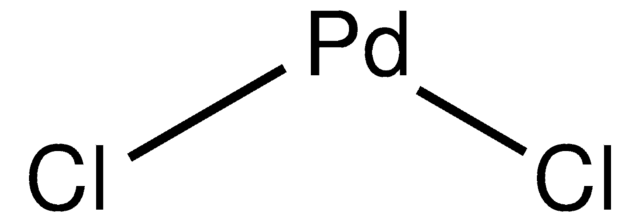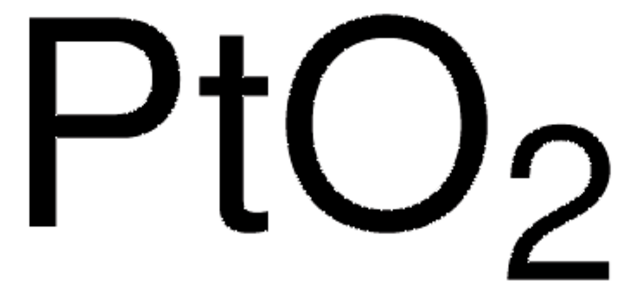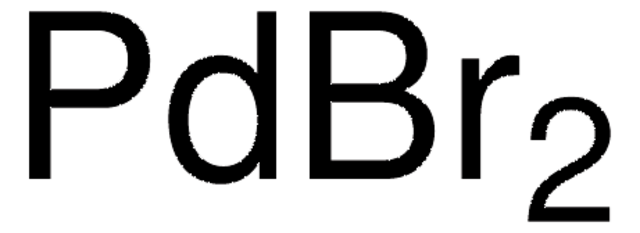520748
Palladium(II) oxide
99.97% trace metals basis
Synonym(s):
Palladium monoxide, Palladium oxide
Sign Into View Organizational & Contract Pricing
All Photos(3)
About This Item
Empirical Formula (Hill Notation):
OPd
CAS Number:
Molecular Weight:
122.42
EC Number:
MDL number:
UNSPSC Code:
12352303
PubChem Substance ID:
NACRES:
NA.23
Recommended Products
Quality Level
Assay
99.97% trace metals basis
form
powder and chunks
composition
Pd, 85-87%
reaction suitability
reagent type: catalyst
core: palladium
mp
870 °C (lit.)
density
8.7 g/mL at 25 °C (lit.)
SMILES string
O=[Pd]
InChI
1S/O.Pd
InChI key
HBEQXAKJSGXAIQ-UHFFFAOYSA-N
Looking for similar products? Visit Product Comparison Guide
General description
Palladium(II) oxide (PdO) is a p-type semiconductor with a band gap of 2.2-2.7 eV. It is widely used as an efficient catalyst for oxidation reactions of hydrocarbons and for fabrication of gas sensors.
Application
Ceria supported Palladium(II) oxide can be used as a catalyst for ozonation of oxalate, to enhance the degradation of recalcitrant organics in polluted water. PdO provides active sites for the decomposition of ozone to surface atomic oxygen. Itcan be used as a cocatalyst for partial oxidation of alcohols on the WO3catalyst.
Signal Word
Danger
Hazard Statements
Precautionary Statements
Hazard Classifications
Ox. Sol. 2
Storage Class Code
5.1B - Oxidizing hazardous materials
WGK
WGK 3
Flash Point(F)
Not applicable
Flash Point(C)
Not applicable
Personal Protective Equipment
dust mask type N95 (US), Eyeshields, Gloves
Choose from one of the most recent versions:
Already Own This Product?
Find documentation for the products that you have recently purchased in the Document Library.
Customers Also Viewed
Qi Li et al.
Environmental science & technology, 44(9), 3493-3499 (2010-04-15)
A novel composite photocatalyst of nitrogen (N) and fluorine (F) codoped titanium oxide (TiO(2)) nanotube arrays with dispersed palladium oxide (PdO) nanoparticles was developed by dispersing PdO nanoparticles into N and F codoped TiO(2) nanotube array template created by anodization
Qian Liu et al.
Journal of nanoscience and nanotechnology, 7(1), 362-367 (2007-04-26)
The optical reflectance and transmittance of Platinum oxide (PtO(x)) and palladium oxide (PdO(x)) thin films for ultrahigh-density optical storage are investigated using Z-scan technique under irradiation of blue laser (442 nm). The power thresholds of the PtO(x) and PdO(x) decomposition
Qi Li et al.
Environmental science & technology, 43(5), 1534-1539 (2009-04-09)
Removal of arsenic species from water by palladium-modified nitrogen-doped titanium oxide (TiON/PdO) nanoparticles was investigated with and without visible light. For the first time, a high degree of As(III) removal undervisible light illumination was demonstrated on oxide photocatalysts. Over 2
Bernd Huber et al.
Nature materials, 5(1), 44-47 (2005-12-06)
Oxide-supported transition-metal clusters and nanoparticles have attracted significant attention owing to their important role as components of model catalysts, sensors, solar cells and magnetic recording devices. For small clusters, functionality and structure are closely interrelated. However, knowledge of the structure
Lin Du et al.
Water science and technology : a journal of the International Association on Water Pollution Research, 63(7), 1539-1545 (2011-04-22)
The electrochemical degradation of Methyl Orange in 0.1 M NaCl solution over RuO(x)-PdO/Ti anode was investigated. Chemical oxygen demand (COD), ion chromatography (IC), Fourier Transform Infrared Spectroscopy (FTIR) and Gas chromatography-mass spectrometry (GC-MS) were employed to detect the intermediates formed
Our team of scientists has experience in all areas of research including Life Science, Material Science, Chemical Synthesis, Chromatography, Analytical and many others.
Contact Technical Service










